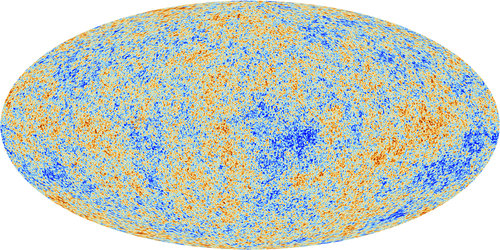Cosmic detectives
Cosmologists recently unveiled the best image yet of the cosmic microwave background – the ‘afterglow’ of the Big Bang – by ESA’s Planck space telescope.
The background is the oldest light in our Universe, imprinted on the sky when it was just 380 000 years old. It shows tiny temperature fluctuations that correspond to regions of slightly different densities at very early times, representing the seeds of all future structure: the stars and galaxies of today.
This animation illustrates the painstaking detective work performed by cosmologists to extract the cosmic microwave background from 15.5 months of data collected by Planck.
The first image in the sequence shows the sources of emission detected on the whole sky at the microwave and submillimetre wavelengths probed by Planck, which range from 11.1 mm to 0.3 mm, corresponding to frequencies between 27 GHz and 1 THz.
The different sources include discrete emission from individual galactic and extragalactic sources, and diffuse radio and thermal emission from interstellar material in the Milky Way.
The cosmologists had to remove all possible contamination due to emission by foreground sources before they could fully explore the cosmic microwave background, which is unveiled in the final slide of the animation.
Using the new map, cosmologists can find clues to the formation and evolution of our Universe since the Big Bang 13.8 billion years ago, and trace the history of star and galaxy formation to the present day.
This week, cosmologists are meeting at a dedicated Planck symposium hosted by ESA’s space research and technology centre, ESTEC, in the Netherlands, to discuss the results and implications of the new cosmology results.
On Wednesday 3 April a ‘public’ session will be streamed live via the web. The session opens at 16:15 GMT (18:15 CEST) and will finish at around 17:30 GMT (19:30 CEST).
Two short presentations will highlight Planck’s contribution to cosmology, and the importance of the map released on 21 March.
Visitors watching the live feed are invited to contribute to the Q&A session by asking questions via Twitter to @esascience using the hashtag #AskPlanck or by emailing them to scicom[@]esa.int.















 Germany
Germany
 Austria
Austria
 Belgium
Belgium
 Denmark
Denmark
 Spain
Spain
 Estonia
Estonia
 Finland
Finland
 France
France
 Greece
Greece
 Hungary
Hungary
 Ireland
Ireland
 Italy
Italy
 Luxembourg
Luxembourg
 Norway
Norway
 The Netherlands
The Netherlands
 Poland
Poland
 Portugal
Portugal
 Czechia
Czechia
 Romania
Romania
 United Kingdom
United Kingdom
 Slovenia
Slovenia
 Sweden
Sweden
 Switzerland
Switzerland


































